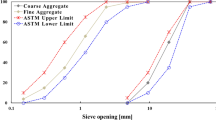Abstract
In many parts of the world, corrosion of reinforcing steel in concrete induced by carbonation of the concrete continues to be a major durability concern. This paper investigates the accelerated and natural carbonation resistance of a set of seven concretes, specifically evaluating the effects of internal curing and/or shrinkage/viscosity modifiers on carbonation resistance. In addition to five different ordinary portland cement (OPC) concretes, two concretes containing 20 % of a Class F fly ash as replacement for cement on a mass basis are also evaluated. For all seven concrete mixtures, a good correlation between accelerated (lab) and natural (field) measured carbonation coefficients is observed. Conversely, there is less correlation observed between the specimens’ carbonation resistance and their respective 28 days compressive strengths, with the mixtures containing the shrinkage/viscosity modifier specifically exhibiting an anomalous behavior of higher carbonation resistance at lower strength levels. For both the accelerated and natural exposures, the lowest carbonation coefficients are obtained for two mixtures, one containing the shrinkage/viscosity modifier added in the mixing water and the other containing a solution of the same admixture used to pre-wet fine lightweight aggregate. Additionally, the fly ash mixtures exhibited a significantly higher carbonation coefficient in both exposures than their corresponding OPC concretes.




Similar content being viewed by others
References
Parrott LJ (1987) A review of carbonation in reinforced concrete. Report 114, Cement and Concrete Association of Great Britain, Wexham Springs 43 pp
Sulapha P, Wong SF, Wee TH, Swaddiwudhipong S (2003) Carbonation of concrete containing mineral admixtures. J Mater Civ Eng 15(2):134–143
Valdez-Tamez PL, Durán-Herrera A, Fajardo-San Miguel G, Juárez-Alvarado C (2009) Influencia de la Carbonatación en Morteros Base Cementos Portland y Ceniza Volante. Ingenierías, Investigación y Tecnología; UNAM 10(1):31–41
Pourbaix M (1974) Applications of electrochemistry in the corrosion science and in practice. Corros Sci 14:25–82
Bentz DP, Weiss WJ (February, 2011) Internal curing: a 2010 state-of-the-art review. NISTIR 7765, US Department of Commerce
Bentz DP, Snyder KA, Peltz MA (2010) Doubling the service life of concrete structures. II: performance of nanoscale viscosity modifiers in mortars. Cement Concr Compos 32(3):187–193
Bentz DP, Snyder KA, Cass LC, Peltz MA (2008) Doubling the service life of concrete. I: reducing ion mobility using nanoscale viscosity modifiers. Cement Concr Compos 30(8):674–678
Bentz DP, Snyder KA, Peltz MA, Obla K, Kim H (2013) Viscosity modifiers to enhance concrete performance. ACI Mater J 110(5):495–502
Bentz DP, Davis JM, Peltz MA, Snyder KA (2013) Influence of internal curing and viscosity modifiers on resistance to sulfate attack. Mater Struct. doi 10.1617/s11527-013-0081-x
Neves R, Branco F, de Brito J (2013) Field assessment of the relationship between natural and accelerated concrete carbonation resistance. Cement Concr Compos 41:9–15
ASTM International (2012) ASTM C173/C173 M-12 standard test method for air content of freshly mixed concrete by the volumetric method. West Conshohocken
Tuutti K (1982) Corrosion of steel in concrete. Swedish Cement and Concrete Research Institute, Stockholm
Haque MN, Al-Khaiat H, Kayali O (2004) Strength and durability of lightweight concrete. Cement Concr Compos 26:307–314
ASTM International (2013) ASTM C33/C33 M-13 standard specification for concrete aggregates. West Conshohocken
Acknowledgments
The authors would like to express their gratitude to the National Council of Science and Technology of Mexico (CONACYT) for the scholarships received by De-Los-Santos and Vázquez for their MsC studies at UANL, to the Scientific and Technological Research Support Program of the UANL (PAICYT) and to CONACYT project number 155363 for the complementary economical support for this project. The authors also thank Charles K. Nmai from BASF Corporation, USA, and Daniel Canizales from BASF Mexico for providing the shrinkage-reducing admixture and the high range water reducer, respectively.
Author information
Authors and Affiliations
Corresponding author
Rights and permissions
About this article
Cite this article
Durán-Herrera, A., Mendoza-Rangel, J.M., De-Los-Santos, E.U. et al. Accelerated and natural carbonation of concretes with internal curing and shrinkage/viscosity modifiers. Mater Struct 48, 1207–1214 (2015). https://doi.org/10.1617/s11527-013-0226-y
Received:
Accepted:
Published:
Issue Date:
DOI: https://doi.org/10.1617/s11527-013-0226-y




